Thinking about cutting out the carbs but worried about how that might affect your cholesterol? You’re not the only one! The relationship between eating fat and cholesterol isn’t complicated, but it IS surprising because there is so much misinformation out there. So today, we’re digging into the scientific truth about keto and cholesterol.
Questions about keto and cholesterol come up a LOT for us at Thinlicious™, and honestly, it’s probably one of the most misunderstood health concerns on the planet!
Today we’ll be spending time talking about a question that gets raised SO much about the health of low-carb diets. Specifically, we’re digging into how low-carb, high-fat diets, aka keto, can affect cholesterol levels.
Buckle up because you’ll likely be surprised (and a little angry) by the end of this post.
Are you ready to lose weight and heal your body for life (without dieting, drugs, or making yourself miserable)?

Our free on-demand video training will walk you through how to make this THE year you set health goals…and keep them.

The Confusion with Fat and Cholesterol
In fact, I’d say at least once or twice a week in our Thinlicious Facebook community, we have someone who is freaking out either because they went to the doctor and have been told they have high cholesterol and are at risk for heart disease and are now trying to figure out what to do, or because they’ve scared away from low-carb or ketogenic diets from well-meaning friends or family members or whoever.
The reality is that there is SO much confusion over this topic. There also is so much misinformation being thrown around, which makes me sad, but also a little angry that so many women are being led astray and given bad information or half-truths.
That’s why today I want to go DEEP and talk about a topic that can feel really confusing in a way that actually makes sense.
This post will answer SO many questions and give you the confidence to keep digging and to advocate for yourself.
Let’s Set the Record Straight Between Keto and Cholesterol
Okay, so back to the big scary word of the day: CHOLESTEROL
Because the reality is that cholesterol really can be a little scary can’t it? We’ve been taught to fear it, even though we haven’t really been taught to UNDERSTAND IT. For almost all of us, all that we really know is that high cholesterol is bad for our hearts.
…Or so we’ve been told.
One look at the high-fat content in most low-carb and ketogenic meal plans might have you wondering, “Is this really safe?” How can this much butter and bacon and eggs and steak really be a good thing?
Maybe you’ve even heard horror stories of people who switched to keto and had their cholesterol levels go up, and now you’re worried that will happen to you too.
Or perhaps you’re ONE of those people who had your cholesterol levels go up after switching to a low-carb lifestyle, and your well-meaning doctor freaked out, and now you’re not sure what to do.
But the truth isn’t quite as simple or straightforward as just saying “high cholesterol is bad.”
And honestly, that’s not even an accurate statement.
BECAUSE NOT ALL CHOLESTEROL IS CREATED EQUAL.
And not only that, cholesterol is ESSENTIAL for your body to function properly.
It is a key building block in the membranes that surround all the cells in our body. It is so vital that if you reduce cholesterol in your diet, your body will simply make more.
In fact, 80 percent of the cholesterol in your blood is manufactured in your liver and has nothing to do with your diet.
But I might be getting a little ahead of myself.
What is Cholesterol?
First, let’s start by understanding what cholesterol is. Cholesterol is a type of fat that is essential for human health. Our bodies use cholesterol to make hormones, vitamin D, and other important substances.
Cholesterol is also found in some of the foods we eat, like eggs, red meat and dairy products.
Cholesterol travels through our bloodstream in the form of lipoproteins, which are molecules of fat and protein. There are two main types of lipoproteins: low-density lipoprotein (LDL) and high-density lipoprotein (HDL).
LDL is often referred to as “bad cholesterol” because it was thought (and is still commonly believed) to lead to the buildup of plaque in our arteries.
HDL, on the other hand, has known as “good cholesterol” because it serves all sorts of healing and cleansing functions in your body.
But the reality is a little more complex. We’ll talk a little bit more about that in a minute.
Why do people say cholesterol is bad?
But before we do, I want to address why cholesterol has such a bad rap.
You see, it actually goes back to the late ’50s and early ’60s, when a researcher named Ancel Keys published a broad, ambitious, and widely cited study that suggested there was a correlation between dietary fat consumption and heart disease.
Essentially, it said that saturated fat led to high cholesterol and that high cholesterol predicted risk for heart disease.
This study became known as the Seven Countries Study and essentially became the basis for all nutritional advice for the next 50 years. That’s a pretty influential study.
The Problem with Outdated Claims
The only problem?
Well, there are several problems, actually.
The Seven Countries Study had some MAJOR problems and basically made a whole lot of claims based on what is now considered flawed data by modern standards.
And yet, even though this study has been completely debunked and widely proven to be problematic in almost every way, it was SO widely adopted as truth when it first came out that it basically became the basis for what was taught in every textbook and medical school.
In fact, it’s STILL being taught, even though what has been discovered and proven repeatedly SINCE that time is:
- saturated fat does not increase the risk of heart disease
- carbohydrates are the number one thing that makes us fat. And being fat is what puts us at higher risk of heart disease
But try explaining that to your doctor when he freaks out because your labs showed an increase in your cholesterol levels because he’s still relying on the outdated and now-debunked lessons he was taught in medical school.
By the way, that’s not the only outdated info they have. Here are 7 important things your doctor won’t tell you about losing weight after 40.
You still with me?
Since the late 1950’s cholesterol has been unfairly blamed for heart disease. This is thanks to the 7 countries study, a myth that is still being perpetuated to this day.
LDL vs HDL Cholesterol
So now that you understand the original source of all this misinformation, let’s now spend a little time understanding how cholesterol works, and especially how it relates to a low-carb diet.
As you’ve likely heard before, there are 2 types of cholesterol: HDL and LDL.
And once again, maybe you’ve even heard that HDL is the “good cholesterol” and LDL is the “bad cholesterol.”
But what does that really mean?

HDL (The “Good Cholesterol”)
First let’s talk about HDL and what it does.
HDL stands for “High-Density Lipoprotein,”. It’s what we call “good cholesterol” because it is essentially the cholesterol in your body. It helps to transport and recycle other fats such as triglycerides, which are the bad fats you find in many processed foods.
HDL is an essential part of keeping your body healthy. So having too little of it can actually be a big problem.
So what’s the best way to RAISE your HDL cholesterol?
Eliminate carbohydrates from your diet and increase your monosaturated fat.
As researchers now know, if your HDL cholesterol is low, it means you are highly likely to be eating a high-carbohydrate diet.
That’s really the first thing you need to understand about cholesterol. HDL cholesterol is GOOD and super essential, and your goal should be to get that number higher if possible.
To do that, you’ll want to cut out carbohydrates while increasing your healthy monosaturated fats. This means you’ll want to consume more:
LDL (The “Bad Cholesterol”)
Okay, so what about the so-called BAD cholesterol, aka LDL cholesterol?
LDL stands for “Low-Density Lipoprotein,” and quite frankly, LDL has gotten a bad rap over the years, but it’s not entirely fair.
When we first started hearing about LDL being the “bad cholesterol,” it was because physicians believed that LDL was the cholesterol that caused the buildup of plaque in our arteries.
However, that’s not actually correct.
LDL ISN’T actually cholesterol. It’s the PARTICLE that CONTAINS the cholesterol and carries it and the TRIGLYCERIDES around your bloodstream.
Now researchers know for certain that it’s not actually the CHOLESTEROL that is the problem. It’s the particle itself, along with the TRIGLYCERIDES that are causing all the problems. The cholesterol is just along for the ride—an innocent bystander.
But this is where things get even more complicated. Not ALL LDL particles are the same or equally harmful.
This is the part that is really important to understand. Some LDL particles are small and dense, while LDL particles are large and buoyant. While the large, buoyant LDL particles are harmless, it is the small, dense LDL particles that tend to get stuck in our artery walls and cause a buildup of plaque and all the other problems we have attributed to cholesterol.
But it’s not actually cholesterol. It’s LDL particles and the triglycerides. And it’s not even ALL LDL particles, just the small, dense ones.
Keto and Cholesterol
So what causes you to have smaller, denser LDL particles and higher levels of triglycerides?
You guessed it: CARBOHYDRATES.
Here’s the truth about keto and cholesterol. When you eat a low carb, high fat diet, the opposite happens.
Your HDL goes up, your triglycerides go down. Then your LDL particles get larger and fluffier and more buoyant, rendering them harmless. These are all changes that dramatically lower your risk of heart disease.
So, why are not all doctors shouting from the rooftop about the benefits of eating a healthy low-carb high fat diet? And why, after switching to a keto diet does your cholesterol number sometimes go UP, rather than go down if all of this good stuff is supposedly happening?
Well, it’s complicated.
But in short, the answer is that cholesterol numbers can often be very misleading and don’t always tell the whole story. This is especially true because the basic cholesterol test that you take in your doctor’s office doesn’t always measure the SIZE of your LDL particles or your triglycerides, which are both of the factors that ACTUALLY indicate whether or not there is a problem.
How to Talk to Your Doctor About Keto and Cholesterol
Unfortunately, many doctors still rely heavily on these numbers to make decisions about treatment and medication, not understanding the entire picture.
This is why it’s so important to find a doctor who understands the importance of looking at the whole keto and cholesterol picture, not just cholesterol numbers when it comes to your heart health.
Look at LDL-P, Not Just LDL
The number that you need to be concerned about is not just your LDL number but your LDL-P number, which is your LDL particle number.
Get a Particle Size Test
It’s also important to get a “particle size test” done so that you can actually see what size your particles are.
That will tell you the story of whether or not there is an actual problem with those particles and allow your doctor to make better decisions about treatment and prevention measures accordingly.
Check Your Triglyceride to HDL Ratio
Likewise, the other number you can be looking at is your Triglyceride-to-HDL ratio.
This number is actually an even better indicator of heart health than just looking at your cholesterol numbers alone. A ratio of less than 2.0 means you’re doing well, but ideally, this number would be 1.0 or lower.
I recently had some bloodwork done just to get a baseline of where I am at, and not surprisingly, my LDL cholesterol and total cholesterol numbers were slightly higher than the standard recommendations.
If a traditional doctor looked at just those numbers, they’d probably show some concern. They might have even try to put me on medication or a “healthy low fat diet.”
But, those numbers don’t tell the whole story.
You see, even though my LDL is elevated, my particles are large and, therefore, not really a problem. More importantly, my triglycerides are low, and my HDL is high, which means that my triglyceride to HDL ratio is only .74, which is basically AMAZING—literally as good as I could hope for.
Suffice it to say, as far as my cholesterol is concerned, I know I’m doing great because I’ve taken the time to learn how it all actually works.
High Cholesterol and Keto
That brings us to the final big question of the day. If you have high cholesterol, should you avoid ketogenic or other low-low carb diets?
NO, not at all. In fact, eating low-carb is probably the very best way to improve your cholesterol numbers.
Just make sure you’re doing it right and following a well-rounded, whole-foods-based keto diet that includes plenty of HEALTHY fats (avoid processed seed and vegetable oils), animal protein, and very few carbs.
I PROMISE you’ll feel so much better when you do, especially now that you understand how cholesterol actually fits in.
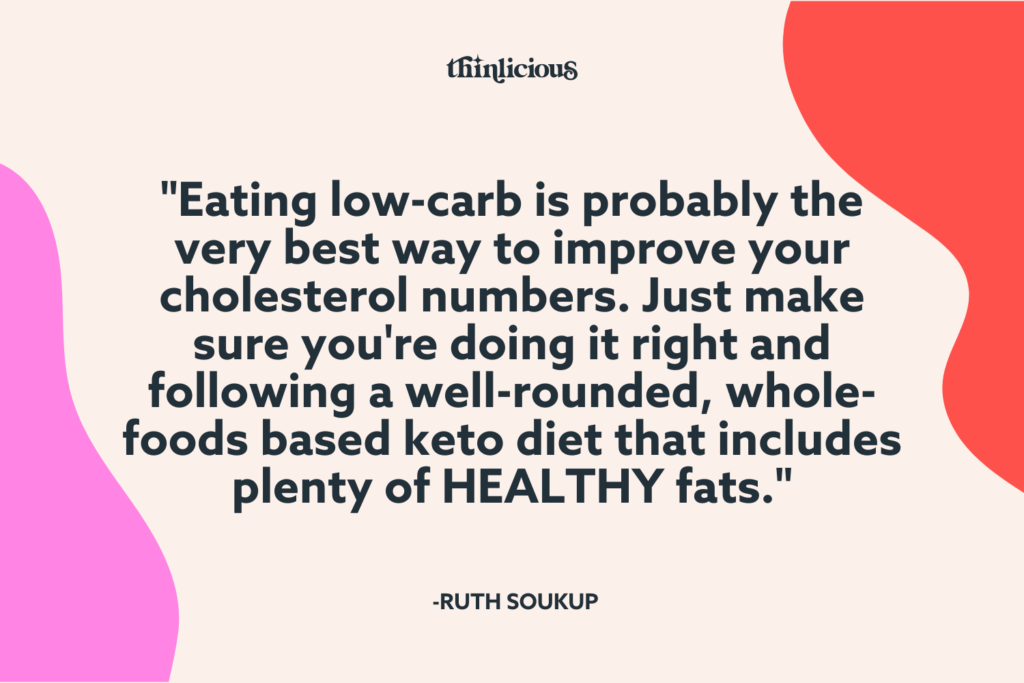
A Summary of Keto and Cholesterol
And I know that was a lot of very technical information in a short amount of time, so just to summarize it all up really quickly:
- Cholesterol is essential for human health. We can’t live without it, and in fact, our body actually CREATES it. If you somehow removed all cholesterol from your diet, your body would keep making it, because you need it.
- Cholesterol has gotten a bad reputation since the late 1950’s when a researcher named Ancel Keyes published a flawed but widely cited study that associated cholesterol with heart disease. That study has since been completely debunked, but not before the damage was done.
- Having more HDL is a good thing. HDL cholesterol, which is often referred to as the “good cholesterol,” is, in fact, good and essential for transporting and recycling other fats.
- LDL cholesterol is often called the “bad cholesterol,” but it’s actually not cholesterol at all—it’s a PARTICLE that carries around the cholesterol and triglycerides. And so it’s not the level LDL itself that matters, but the actual SIZE of the particle that matters. Small particles are bad. Big particles are good.
- Unfortunately, most cholesterol blood tests don’t account for the size of the particle, and can therefore be very misleading. And unless your doctor is specifically looking at particle size, it could look like your LDL number has gone up when in fact, your PARTICLES have gotten larger, which would actually be a good thing. So make sure your doctor is looking at particle size.
- A better number to pay attention to is your Triglyceride-to-HDL ratio. A ratio of less than 2.0 means you’re doing well, but ideally, this number would be 1.0 or lower.
- The very best way to IMPROVE your cholesterol is through a healthy, well-balanced diet that is low in carbohydrates but rich in healthy fats, such as avocados, coconut oil, butter, and meat, but that avoids unhealthy trans fats and processed seed oils and especially avoids highly processed food and sugar.
In case you’re wondering, this is basically what the Thinlicious way of eating is all about. Educating yourself about how this stuff actually works and what is actually going on in your body is such an important first step!
Want to hear more? Listen to this podcast, HERE!
Next Steps
Keep reading and educating yourself with these two helpful posts:
- Yes, You Really Do Need More (Healthy) Fat in Your Diet. Here’s Why.
- Heart Health and The Low Carb Lifestyle: How It All Works Together
Want to learn about Thinlicious and get started? Check out our free (and super helpful!) guide to your metabolism after 40.
Ready to lose weight and get healthy for life without dieting, drugs or making yourself miserable? Our brand new (and totally free!) on demand video training will help you understand why it’s been so hard and what do to about it.
What if you could actually take control of
your health in just 10 days?
It’s not your fault you can’t lose weight as a woman over 40 even though you’ve likely tried literally everything. Your metabolism probably feels broken and your hormones are likely all out of whack.
But you can fix it all with ONE simple change: eliminate sugar. We make it super easy with daily lessons teaching you the science behind what makes us gain weight in our midlife and beyond! Are you ready to get started now?

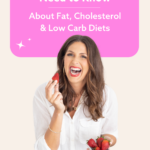
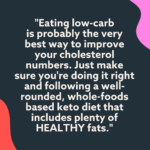
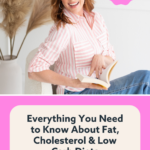

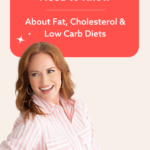
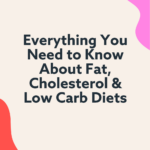
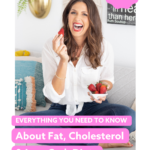


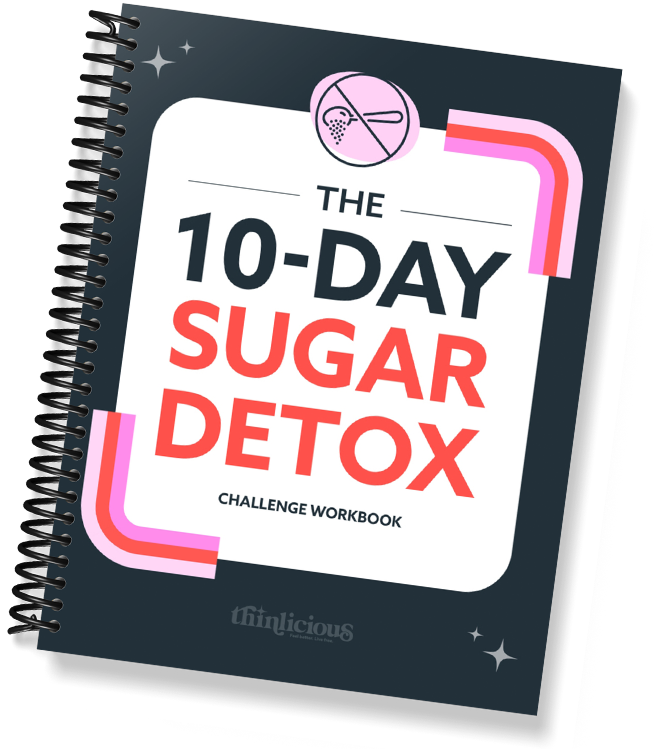
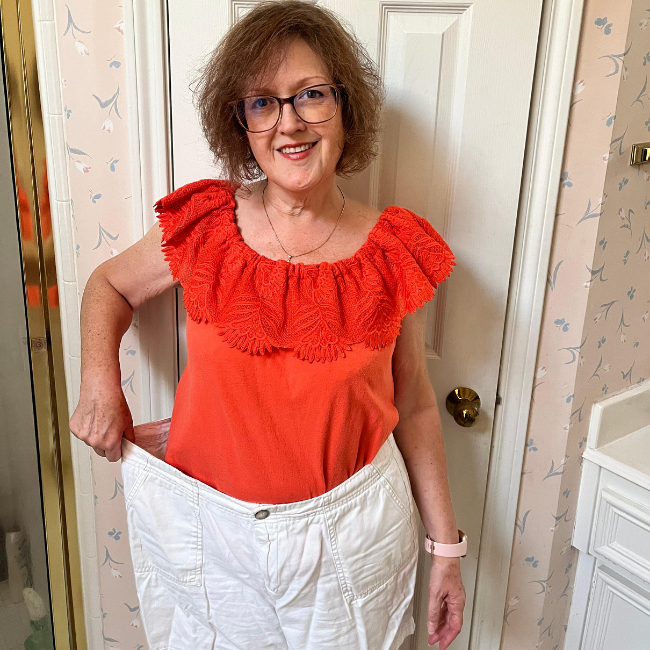





Thank you for the aggressive information shared by you concerning keto and cholesterol,it was very interesting and a balanced knowledge which the doctors will not tell you
Keto controlled my diabetics